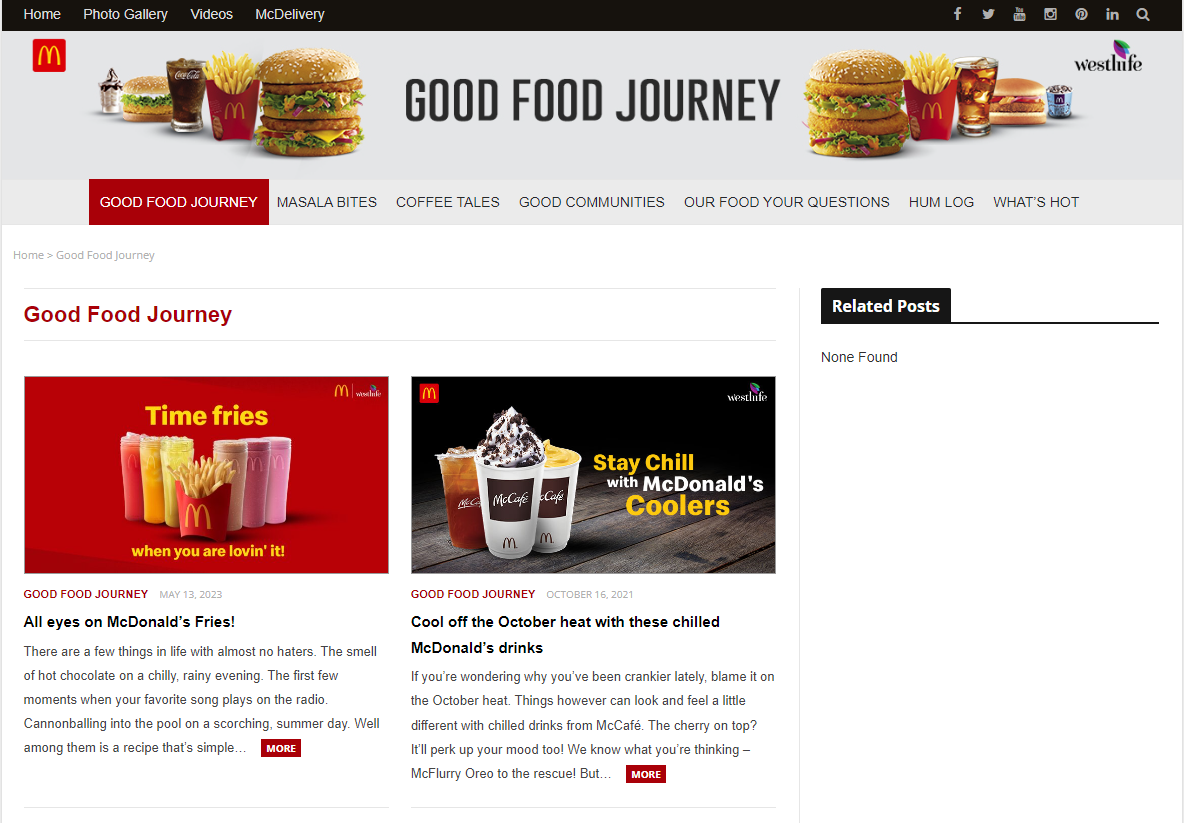A franchisor owns a business that sells businesses to franchisees — say that 5 times fast. As complicated as that tongue twister is, so too can be franchise marketing. But that’s why we’re here — in the thick of the research and the writing — so you don’t have to be.
Here, we’re looking at a few of today’s most recognizable franchises, examining how they communicate with their audience and apply consistency to their marketing strategies amid the slightly disconnected nature of the business model.
First things first …
The Basics of a Good Franchise Marketing Strategy
When you think franchise, you likely gravitate toward uberly successful fast food chains like Subway, McDonald’s, and Dunkin’ (or Tim Hortons for any fellow Canadians out there. This is a call for help).
(Just kidding).
But, franchises extend beyond just restaurants and into other industries, too. Common examples include:
- Hotels.
- Resorts.
- Gas stations.
- Gyms and fitness centers.
The challenge? Trying to maintain a consistent brand image throughout multiple geographic locations and under the discretion of different franchise owners. The solution? A franchise advertising strategy that can reasonably balance consistency customization to suit a specific target market.
Oh, and just to clarify — there are technically two types of franchise marketing: operational and developmental. The former is concerned with acquiring and retaining new customers at individual franchise locations, while the latter, franchise development marketing, focuses on enticing prospective franchisees to buy into your business. In this article, we’re focusing on the former — operational franchise marketing. However, the tools and tactics we’ll highlight here may have some crossover value so, keep that in mind!
Let’s start with the basics.
Create Clear Brand Guidelines
Because of the nature of the franchise business model, store locations are scattered throughout a plethora of regions — each with its own unique audience. Creating a set of clear brand guidelines helps establish a baseline for branding and an outline for a marketing plan at the franchisee level.
Of course, deviations are expected (and encouraged) to better align marketing campaigns with a region-specific audience. However, having that throughline strengthens your brand image and keeps franchisees on the right page. Also, it’s crucial for effective franchise marketing to ensure brand loyalty across all franchise locations.
Moreover, implementing franchise-wide guidelines, rules, and limitations on details like logo usage, colors, and messaging can provide another layer of brand consistency for a marketing plan, ensuring that any messaging or imagery is still recognizable as the franchisor.
Subscribe to
The Content Marketer
Get weekly insights, advice and opinions about all things digital marketing.
Thank you for subscribing to The Content Marketer!
Have a Strong Product or Service
Having a solid offering, whether a product or a service, can do a lot of the heavy lifting when it comes to franchise advertising. Everyone knows what a Big Mac is, and no matter the franchise location people go to, they know they can find one there. This consistency is key to building brand loyalty and ensuring franchise success.
So, whatever you’re selling, make sure it’s solid! This is the first step in creating an effective marketing strategy that potential franchisees and customers will find appealing.
Additionally, consider utilizing white label services to enhance your offerings and streamline your business operations.
Set Goals and Measure KPIs
A staple for every marketing campaign — franchise-oriented or not — is goal setting. In this case, some of the apparent target achievements would be to:
- Strengthen brand identity and increase brand awareness.
- Drive revenue among franchise locations.
Here are a few key performance indicators (KPIs) to measure each:
For brand awareness:
- Social media reach.
- External brand mentions.
- Media mentions.
And for revenue generated via marketing activity:
- Sales.
- Cost per lead.
- Traffic to lead ratio.
Franchise Marketing Tips: Tools and Tactics to Use
OK — onto the stratagem. These 4 tools and tactics are excellent ways to kick off and maintain a solid franchise marketing strategy, so read carefully!
Leverage Local SEO
Local search engine optimization (SEO) is paramount for this particular type of marketing. Why? As we alluded to earlier, your brand may be national or even global, but your audience for each franchise location is not. Thus, copy-and-paste messaging isn’t always the best route to drive customer engagement.
The best place to start is by localizing your franchise website. To get the most value out of local SEO, each franchise location should have its own page on your website — or even its own domain. Then, link them together so it’s easier for the algorithms to learn that they’re related.
On those pages, be sure to include:
- A map of the area.
- Contact information for each location within that range.
- The address(es) of each franchise.
And while you’re at it — make sure to create and optimize a Google Business Profile for your franchisee location, ensuring that all information included is kept up to date, like store hours and contact info.
For digital marketing in a digital world, local SEO is the new local marketing. Yes, getting regional radio or TV spots can be beneficial, but these days it’s all about that online presence — since that’s where most people are. This approach is essential for an effective franchise digital marketing strategy aimed at franchise growth.
Do Content Marketing
Content marketing is everything (and we’re not just saying that because we’re biased). Not only does it do wonders to support a robust SEO strategy (which 88% of marketers plan to maintain or increase their use of in 2023), but it’s also engaging.
These days, content in the form of short articles/posts and videos are the top two content types that B2C marketers are using. So, take advantage of that by producing marketing material such as:
- Writing compelling blog articles.
- Producing engaging videos.
- Being active on social media (more on this just below).
Use Social Media Marketing
Perhaps one of the best ways to engage audiences from all over, using social media as part of your franchise marketing plan is evident.
But don’t leave it up to your franchisees to ideate and publish content. For some, that’s a daunting task and can be challenging to handle in tandem with managing a store location.
Instead, create social media templates that franchisees can take and plug in relevant information based on their particular store and region. This could include weekly or monthly location-based promos and offers or even product announcements that are exclusive to a particular part of the country or world.
Oh, and we can’t forget about customer service. More and more, consumers are expecting faster and more convenient responses to their inquiries. X (formerly known as Twitter) is a great place to set up localized marketing and customer service accounts to manage this.
Deploy a PPC Campaign
PPC campaigns are designed to be highly targeted, which is why it makes perfect sense to build a franchise PPC strategy.
Your marketing effort could prove futile without an expertly managed PPC campaign. Your best options here in terms of a marketing channel to run PPC material on would be Google Ads and/or Facebook Ads — the two most popular services for this advertising format.
In the thick of it, remember to:
- Write short, compelling ad copy.
- Monitor your keywords.
- A/B test your ads.
- Make bid adjustments as necessary.
Learning From the Best: Top Franchise Marketing Examples
With all of that mouthwatering information out of the way, let’s jump into some real-world examples. These are some of our favorite pieces of franchise marketing content.
Subway’s New “Subway Series” Campaign in Canada
A franchise brand to take note of, Subway rolled out one of its largest marketing campaigns to date (in Canada).
The brand leveraged professional athletes from Canadian sports teams to introduce its new menu items. This is a great example of nationwide localization, using the appeal of beloved local athletes to market to a whole country.
McDonald’s India Blog
Something the American McDonald’s website lacks, McDonald’s India has a unique website that offers blog and video content, newsletters and more that are all specific to that country.

For a potential customer, this certainly provides a lot of helpful information and engaging content. But for franchisees in that area, it undoubtedly affords a lot of insight and inspiration for franchise marketing efforts, too.
A quick look around reveals that they have marketing content for just about everything. And even more specific to franchise marketing, a “Good Communities” tab that, on occasion, will highlight something positive about a specific store in India, like this.
What’s Ahead for Your Franchise?
So, now we know:
- The basics of franchise marketing, including creating comprehensive brand guidelines and setting goals.
- Tools and tactics to flesh out your franchise marketing strategy.
- And, a few real-world examples of franchise marketing in action that, we hope, inspire your strategy!
Successful franchise marketing can certainly appear not-so-straightforward at first but, rest assured, with a little customization and tweaking to suit region-specific audiences, you’ll get the hang of it in no time. By focusing on local franchise marketing, deploying a strong franchise digital marketing strategy, and fostering brand loyalty, you’re setting the stage for franchise growth and ensuring your franchise opportunity stands out in a competitive market.
Editor’s Note: Updated July 2024.





